Related Research Articles

A cartoon is a type of visual art that is typically drawn, frequently animated, in an unrealistic or semi-realistic style. The specific meaning has evolved, but the modern usage usually refers to either: an image or series of images intended for satire, caricature, or humor; or a motion picture that relies on a sequence of illustrations for its animation. Someone who creates cartoons in the first sense is called a cartoonist, and in the second sense they are usually called an animator.

Viz is a British adult comic magazine founded in 1979 by Chris Donald. It parodies British comics of the post-war period, notably The Beano and The Dandy, but with extensive profanity, toilet humour, black comedy, surreal humour and generally sexual or violent storylines. It also sends up tabloid newspapers, with mockeries of articles and letters pages. It features parody competitions and advertisements for overpriced 'limited edition' tat, as well as obsessions with half-forgotten kitsch celebrities from the 1960s to the 1980s, such as Shakin' Stevens and Rodney Bewes. Occasionally, it satirises current affairs and politicians, but it has no particular political standpoint.

The SEPECAT Jaguar is an Anglo-French jet attack aircraft originally used by the British Royal Air Force and the French Air Force in the close air support and nuclear strike role. It is still in service with the Indian Air Force.
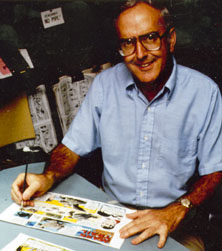
A cartoonist is a visual artist who specializes in both drawing and writing cartoons or comics. Cartoonists differ from comics writers or comic book illustrators in that they produce both the literary and graphic components of the work as part of their practice. Cartoonists may work in a variety of formats, including booklets, comic strips, comic books, editorial cartoons, graphic novels, manuals, gag cartoons, storyboards, posters, shirts, books, advertisements, greeting cards, magazines, newspapers, webcomics, and video game packaging.

Andy Capp is a British comic strip created by cartoonist Reg Smythe, seen in the Daily Mirror and the Sunday Mirror newspapers since 5 August 1957. Originally a single-panel cartoon, it was later expanded to four panels.
Buster may refer to:
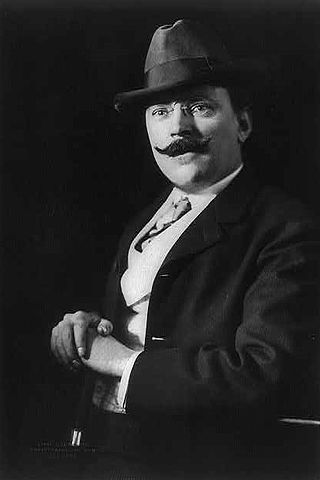
Richard Felton Outcault was an American cartoonist. He was the creator of the series The Yellow Kid and Buster Brown and is considered a key pioneer of the modern comic strip.
A British comic is a periodical published in the United Kingdom that contains comic strips. It is generally referred to as a comic or a comic magazine, and historically as a comic paper.
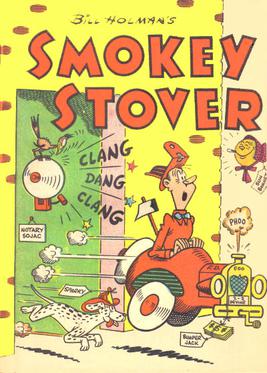
Smokey Stover is an American comic strip written and drawn by cartoonist Bill Holman from March 10, 1935, until he retired in 1972 and distributed through the Chicago Tribune. It features the misadventures of the titular fireman.
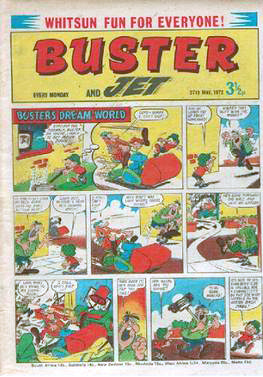
Buster was a British comic which began publication in 1960, originally published by IPC Magazines Ltd under the company's comics division Fleetway, then by Egmont UK Ltd under the same imprint until its closure in 2000. Despite missing issues due to industrial action during its run, the comic published 1,902 issues in total. The comic carried a mixture of humour and adventure strips, featuring the title character Buster and a host of other characters.
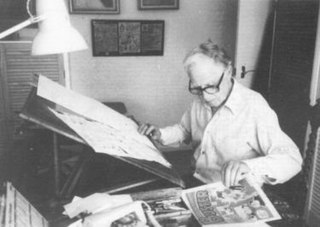
Reginald Edward Parlett was an artist from England who had a career of drawing for comic books that lasted for 66 years.
Antonio Prohías was a Cuban-American cartoonist. He was the creator of the satirical comic strip Spy vs. Spy, which he illustrated for Mad magazine from 1961 to 1987.

David Wiley Miller is an American cartoonist whose work is characterized by wry wit and trenchant social satire, is best known for his comic strip Non Sequitur, which he signs Wiley. Non Sequitur is the only cartoon to win National Cartoonists Society Divisional Awards in both the comic strip and comic panel categories, and Miller is the only cartoonist to win an NCS Divisional Award in his first year of syndication.
Where the Buffalo Roam was a comic strip by Hans Bjordahl that ran from 1987 to 1995. It was published on Usenet starting in 1991, making it one of the first online comic strips. Witches and Stitches was published earlier, in 1985, on CompuServe.
The Drunken Bakers is a strip cartoon in the British adult humour magazine Viz created by writer Barney Farmer and artist Lee Healey. It depicts the alcohol-dominated lives of two forlorn bakers who attempt to run a small bakery. The strip was adapted into a video-art installation piece by the artist Mark Leckey in 2006, and a novel 'Drunken Baker' by Barney Farmer in 2018.
Tom Paterson is a Scottish comic artist who drew characters for Fleetway in 1973–1990, and D.C Thomson from 1986 to 2012. As of 2013, he currently draws strips for Viz. He lives in Leith, with three children, and is a Hearts supporter.
Lew Stringer is a freelance comic artist and scriptwriter.
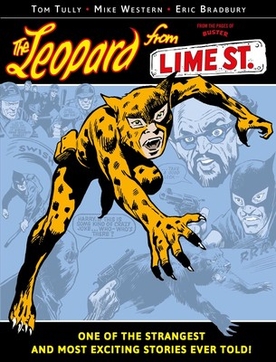
The Leopard from Lime Street was a comic strip appearing in the British comic Buster from 1976 to 1985. Written by Tom Tully, it was drawn in a 'realistic' comic style by Mike Western and Eric Bradbury, much like Marvel Comics's Spider-Man comic, in direct contrast to the stylized cartoony style of the rest of Buster.

Viz: The Computer Game is a single player racing game based on the Viz adult comic which was released in 1991 by Virgin Interactive. The game's music was composed by Jeroen Tel.

Roger Rabbit is an animated anthropomorphic rabbit. The character first appeared in author Gary K. Wolf's 1981 novel, Who Censored Roger Rabbit? In the book, Roger is second banana in a popular comic strip, "Baby Herman". Roger hires private detective Eddie Valiant to investigate why his employers, the DeGreasy Brothers, have reneged on their promise to give Roger his own strip. When Roger is found murdered in his home, Valiant sets out to look for the killer, with the help of Roger's "doppel".
References
- ↑ "Internet Archive Wayback Machine". Web.archive.org. 2008-09-20. Archived from the original on 2008-09-20. Retrieved 2012-11-15.
{{cite web}}: Cite uses generic title (help) - ↑ "SEPECAT Jaguar in detail - Photo 09". Sepecat.info. Retrieved 2013-06-25.
- ↑ "Vintage Framed Viz Comic Strips". Tonyvalderama.com. Archived from the original on 2013-02-26. Retrieved 2012-11-15.
- ↑ TV and Radio. "Appalling hilarity". London: Telegraph. Retrieved 2012-11-15.
- ↑ "UK | Viz puts on a show". BBC News. 1999-10-18. Retrieved 2012-11-15.
- ↑ Chapman, S (1999). "Advertising as information". Tobacco Control. 8 (3): 348. doi:10.1136/tc.8.3.348. PMC 1763961 .
